Not long after rancher Rob Krentz was murdered, Cherlyn Gardner Strong moved to the Arizona-Mexico border. In the continuing struggle with the issues of illegal aliens and drugs - and the cartels that service both - many have said that those who live along the border should just buck up and accept the border for what it is. After all, they argue, you choose to live there, you could just move away.
Really? Is this the country that we live in, where people are expected to just sell their properties - some of which have been in the family for generations - and just retreat? If that is your argument, how much of our land are we supposed to give away? Isn't there an obligation that the federal government should do its job and ensure that the border is secure? Don't citizens have a right to live on property that is a part of the United States and that they own without being victimized?
Cherlyn gave me permission to post, in full, her recent article of what life is truly like living along the border, the beauty, the inconvenience and the reality.
Life on the Arizona-Mexico border: A look at life in my neck of the woods
by Cherlyn Gardner Strong
My topic is usually the paranormal here on the Tucson Citizen website. However, we bloggers are granted the freedom to write off-topic. Today, my topic is my life on the Arizona-Mexico border.
It is my hope to provide a different perspective of life on the border for anyone interested in considering a different perspective. I do have a lot to say about it.
I live in Santa Cruz County, but not in a city. I am in the forest east of Nogales, along the border. My experiences on the border likely don’t match those living on the border in Cochise or Yuma counties. Although I did live for one year in Three Points (Pima County) and can certainly speak for those folks. I can honestly say that life there is impacted to some degree by illegal crossers, especially those who live further to the south, around the Buenos Aires Wildlife Refuge.
Yet, life where I live in the rugged mountains, surrounded by the Coronado National Forest, it is much different than it was for me in Three Points.
Life on the rural border is different for everyone, all along the Arizona border. One cannot state that the problems that they face on a daily basis are exactly the same for someone else who may live just 5 miles away from them along the border. That is a fact. This is the main reason that there is no simple solution to the very complex border issue. It depends somewhat on where you live along the border. You can’t count on location to determine what those issues might be either. The traffic from Mexico does tend to shift occasionally all along the border to prevent smugglers and illegal crossers from getting caught. At the moment, I live along one of those well traveled routes.
How I ended up here
When I found a remote rental home advertised in the forest on the border, I jumped on the opportunity for a couple of reasons. First, it allowed me the solitude to write in one of the most beautiful areas in Arizona. Secondly, my great great grandfather, Thomas Gardner, was an Arizona pioneer. He was one of the first white settlers in Santa Cruz County, initially settling not very far from where I live.
My great great grandfather immigrated, legally, from Scotland. He married Gertrudis Apodaca, from Mexico. Their son married a woman from Mexico. Their son’s son married a woman from Mexico. Coupled with my Mexican lineage on the maternal side of my family, my lineage is clearly Mexican.
I suppose my moving to the area provided me with a chance to live like my great great grandfather. There are differences, of course. I have modern day conveniences, like electricity, running water, Internet, phone and a motorized vehicle. These things were not available to him back in the mid-1800s. He dealt with frequent attacks by the Apache. I don’t need to worry about that today. My situation is different.
Not long after I gave my deposit on the house, rancher Rob Krentz was murdered in Cochise County, near Douglas. After reasoning with my husband, I insisted that my dad was born in and grew up in this area, and I felt it was still safe. I’ve camped in the area since I was a small child. Douglas is some 100 miles away, depending on which route is taken. Cochise County does have different border related issues than Santa Cruz County.
Additionally, the home is safe with security doors and windows. There is a high level of Border Patrol presence. We also own firearms.
I was very comfortable with the decision, so we proceeded with the move. The first trip we made with our possessions to the home, we found ourselves pulled over by the Border Patrol on the way back, just a couple miles into our return journey to Tucson. Our vehicle was checked for illegals and for drugs. The agent addressed my husband by name, without my husband offering it, since our plate was run by the agent prior to being pulled over. We informed the agent that we were moving to the area and he said that it would take a while for the agents in the area to recognize us as residents.
After a friendly chat with the agent, we stopped in Sonoita to grab a bite to eat. After dinner, we drove through the Border Patrol checkpoint north of Sonoita. A commander approached the vehicle and asked what we ate for dinner. Based on that question and the conversation that followed, the agents had been watching us, and they had done some homework on us. Although the experience was initially unsettling, we did realize that they were just doing their jobs. Then, we were further enlightened by the Border Patrol.
We were told two things during that checkpoint stop. First, we should expect to be approached by a representative of a drug cartel. To handle this visit properly, we are not to show fear, nor are we to assist them in any way. Second, we should expect one or more late night visits from an illegal or illegals. We are not to assist them either. We were assured that the Border Patrol agents are always 30 seconds away by phone if we need them, for which I am thankful.
Despite the warning, neither scenario we were warned about has happened. However, it has happened to each and every one of our handful of neighbors who are spread out in this remote wilderness. We are told that it is only a matter of time. It could happen while we are out gathering firewood, away from the house and far from any phone. There is no cell phone service available in the area.
Living in the forest is quite a unique experience. It also requires putting up with some inconveniences.
Inconveniences
We live miles south of the warning signs, so the forest is not the most popular tourist area. Additionally, the United States Postal Service recently halted mail delivery to the homes. The mail carrier had a scary experience involving an illegal border crosser. So, mail is sent to a group of lock boxes in the forest. I was informed by the post office that the lock boxes do get broken into. Therefore, I have my mail sent to town, about 20 miles away.
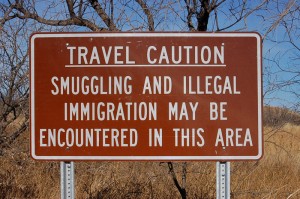
Warning sign
It is certainly baffling that the government acknowledges a problem with the warning signs and also refuse to deliver mail to the homes, due to dangers faced by mail carriers. Yet, according to what is presented by the media, the border is safe as it has ever been. Well, the mail used to be delivered to the houses, so the fact that the mail carriers won’t deliver mail to the homes tells me that this statement is not entirely true.
A UPS driver also had a scary experience here. Due to that, there is some talk of UPS also halting service to the area. UPS still delivers at the moment. Their brown truck resembles a brown streak these days. It roars through this area like a Pony Express rider with a band of Apache in pursuit. UPS driving at high speeds through the area must minimize their chances of a dangerous encounter with an illegal.
There aren’t very many visitors around here otherwise. Occasionally, rockhounds, birdwatchers, hunters and campers do visit, generally without incident. We generally don’t get much other daily traffic around these parts, except for the few local residents and the Border Patrol. The Border Patrol drives by countless times a day. They also drag the road every day to clear any footprints on the dirt road from the night before, so they can better track illegals. The perimeter of our property has had many footprints cleared away. The footprints that have appeared overnight weren’t ours. None of these feet have found their way in the darkness to our front door.
The agents still don’t know us, due to some turnover and shift changes. A routine trip to the grocery store is nearly always interrupted by the Border Patrol pulling us over. They run our license plate, but our address does not show up where we live. The MVD mailing address does not match our home address, since we can’t get mail delivered to the house, which does add to the inconveniences.
We put up with being pulled over, and sometimes searched, because the agents are just doing their jobs.
The trip to Nogales is rather interesting, since much of the activity occurs between here and there. This is the same stretch where two off duty Nogales police officers were threatened by the drug cartels. The officers were told to not interfere with drug smuggling operations while off-duty.
One trip to the grocery store made me nervous. My husband and I spotted a vehicle that had backed far off the road. It didn’t look like the vehicle owner was camping. At the same time, we saw a Border Patrol agent on an ATV quickly approaching behind us. He pulled off the road near the vehicle. We assumed that he was preparing to question the vehicle owner. As we proceeded a couple miles ahead, two Border Patrol trucks appeared from nowhere with their sirens blaring. We pulled over, and four agents rushed our vehicle with their hands ready to pull their guns from their holsters. All they found were me and my husband with our three Chihuahuas. We, and our dogs, all have the proper identification, should we be asked for it.
They said that we were pulled over because another agent radioed in that a vehicle, like the color of ours, was spotted “loading up”. We informed them that they were probably looking for the vehicle a couple miles back. Later, on the way back from the store, we pulled over a Border Patrol truck with a couple agents inside of it. We asked them if the person in the vehicle that matched ours was apprehended. They had no idea what we were talking about, they said.
I do feel strangely safe with the Border Patrol all around us, despite the dangerous activity. Also, despite agents surrounding our vehicle in an apparent case of mistaken identity. As long as they aren’t trigger happy, it’s tolerable.
While I feel relatively safe, I do fear for the safety of the illegals who are funneled through here.
Dead Bodies
The rugged terrain of the mountains and the lush trees do tend to keep crossers well hidden on their journey north. It also keeps the dead bodies hidden. Two bodies were recently found near my home in relatively advanced stages of decomposition. Not all bodies that are found will be found in the open, if they are ever found. There are abandoned mine shafts, as well as very deep open pit mines scattered throughout the forest. You can’t see the bottom standing on the outside of some of them.
I also cringe every time I see the vultures circling. I am never sure if breakfast or lunch for the vultures is animal or human.
With very few people in the area and few tourists, many of the bodies of illegal crossers will never be found. Yes, they do die so close to the border.
My dad came across a group of illegals a couple of weeks ago by the side of the road. They were tired, hungry, thirsty and sore. They had wandered through the forest in circles for days because they didn’t know which way was north. They gave up and wanted to be turned in to the Border Patrol. Had my dad not found them, the chances are high that they would have added to the unknown body count in the area.
Snipers / lookouts on the mountain tops
Even with the heavily concentrated Border Patrol presence in the area, the smugglers have a huge advantage. Their vantage point from various hilltops and peaks allow them to direct traffic through the area, without Border Patrol even knowing that anything is amiss. Apprehensions may be down, but that could be because the smugglers have an outstanding system in place, keeping the people and drugs out of the path of the agents, preventing apprehensions.
Additional technology in the area would help the Border Patrol immensely, as well as a better ability to communicate with each other. An agent recently revealed in a casual conversation that sometimes their radios don’t work in the area.
The snipers and lookouts don’t scare me. If I don’t mess with them, they won’t mess with me. If I come across any bundles of anything, I am not going to bother it. That’s not my job as a resident. That’s for our fine government to figure out. If the police stay safe by complying with orders from the cartels to look the other way, then what’s good for the goose…
The only other thing that I won’t do is travel through the forest alone at night. The forest is a much different place at night. If I discover that I’ve run out of milk in the evening, it isn’t wise to hop in the car and drive 20 miles on a dirt road through the forest to the store. If I must travel in an emergency, then I will ask the Border Patrol to make sure I get to town safely. Whether I ask them or not, they do maintain a presence between here and town at all times.
A common comment that I receive from well meaning friends and acquaintances is that civilians should not be living here along the border. My viewpoint is that I live in the United States. Clearing out the residents just gives the cartels a larger area to control. How far into the United States are we going to allow for illegal activity?
Another thing that has bothered me is the constant attention on the crime numbers in Phoenix. Phoenix is 180 miles north of the border, yet the talking heads imply that it is a border city. If nothing is done to control the activity of the cartels, then Phoenix may actually become a border city someday.
Personally, I am tired of the many misconceptions related to the border. Particularly the tendency of the media to group all the issues into one unclear issue that doesn’t apply to every area along the border.
Maddow’s Misconceptions
One of the reasons I am writing this post, is due to a recent airing of The Rachel Maddow Show. I am rather disappointed with Maddow’s condescending and incomplete coverage of the very real concerns faced in certain sections of the border. The boundary that divides us from Mexico is visually apparent on a map. However, life along border is not as apparent and constant as that dividing line seen on a map.
Maddow recently sent her staff to Nogales to see the border fence. To demonstrate a point, Maddow showed a picture of her staff member walking mockingly along the fence. The entire event was handled by Maddow and her staff like it was a joke. The problem is, this particular stretch of fence is not what concerns us. It’s the fence where I live in the mountains that deserves a good deal of attention. It’s the fence where much of the traffic actually passes through. There are many other stretches like ours, all over entire length of the border. In some places, there is no fence, only a marker to indicate the border.
Maddow is welcome to send her staffers to our stretch of fence in the mountains and see just how cocky they look strutting by that one. I’m sure that she won’t. There are many holes in the fence due to wildlife needing to cross back and forth from Arizona and Mexico. If you think that only animals take advantage of the holes in the fence, you are quite mistaken.
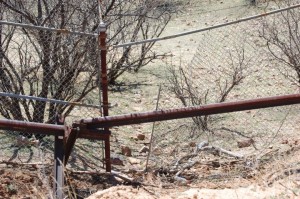
"Secure" border fence near Lochiel
Adding to my frustration is Maddow’s avoidance of a particular fact that has been presented to her at least twice by local law enforcement.
I’ve seen two interviews with Maddow and Santa Cruz County’s Sheriff Antonio Estrada. In both of those interviews, Estrada said that there is really not much of a problem in Nogales, but most the illegal activity actually occurs in the mountains and canyons outside of town. Estrada hasn’t elaborated on that tidbit of information he’s disclosed and Maddow has never questioned it. By questioning it, I mean asking simple questions like: Do people live in the canyons and mountains? What types of things happen in the canyons and mountains? Should we talk to a Border Patrol agent in the heavily traveled areas to get the real scoop?
Nope, it will never happen. Maddow would have to admit that she doesn’t know all the facts.
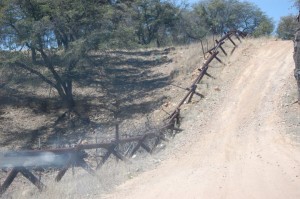
Another fence section in Lochiel
Instead, Maddow has responded to Estrada’s tidbit of exposing where the action is, by putting on the baffled face, holding up her hands, and shaking her head in disbelief that anything could be amiss on the border, since the City of Nogales is so safe. Her avoidance of where most illegals actually cross is baffling. Her reaction is an insult to those of us on the rural border who actually see the illegal activity and live with it going on around us. Her reaction to what she perceives to be a non-issue, is much like the faux pas made by Wisconsin’s Peggy West, talking so confidently about an issue that she knows very little about.
It’s not only Maddow who doesn’t clearly see border issues. It’s pretty constant among all members of the media.
I’ve seen accurate blogger reporting, from bloggers who actually live along the border. I trust a border blogger’s word more than I trust anything from the media.
When my dad was a child in the area, sure there were plenty of illegals who passed through. That’s nothing new. It was a different era, though. My grandparents provided food and water to those travelers on foot who needed it. They were never hurt by an illegal.
The drug cartels, however, didn’t direct human traffic through here, sitting on hilltops and peaks with their automatic weapons.
Funneled traffic
In a recent Tucson Weekly article, the Border Patrol spoke of their strategy to funnel illegal activity to this and other remote areas. This strategy keeps the activity away from populated areas. So, in Rio Rico, Tubac and other formerly high activity locations, the people who live there have noticed that there has been a significant decrease in traffic near their homes. They attribute it to less illegals entering the U.S.
I see things differently in my neck of the woods.
It doesn’t take a rocket scientist to figure out that the traffic is still coming through. It’s coming through somewhere else where the masses don’t see it. Again, I’ll emphasize that the mountain terrain does put the smugglers at a huge advantage from their vantage points on the hilltops and peaks.
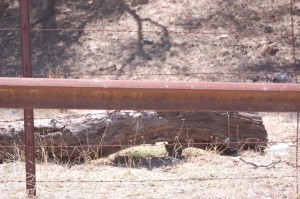
Another section of the fence in Lochiel
Despite the dangers that exist in the area should I cross paths with the wrong people, I do love it here. It is quiet and beautiful. I might feel differently if I were the victim of a crime. If the Border Patrol pulls out from the area, or if they significantly decrease the agents covering the area, I might consider moving.
During my great great grandfather’s time in this area, he faced a different problem, in the form of frequent attacks by the Apache. While on a trip to Tucson for supplies, he was shot through the lungs by Cochise, Chief of the Apache. My great great grandfather survived the attack. Not all their problems involved violent attacks. Sometimes those quiet feet in the darkness of the night would come to steal cattle and horses from the settlers.
So, my great great grandfather decided to move his family north of here to Sonoita, near Fort Crittenden. Living near the fort wasn’t any safer. Up to 8 soldiers at a time were stationed at the Gardner ranch for two-week periods to provide additional protection. Some may argue that white man invaded the home of the Apache, so it was their own fault for moving here.
Things haven’t changed that much. Residents here are protected by the Border Patrol. Perhaps the military might also be dispatched to the area to provide additional protection.
That would bring things full circle, back to life as it was in Southern Arizona in the 1800′s.
My life here is significantly less dangerous than it was for my great great grandfather. The activists would like to argue that the land once belonged to Mexico. While this is true, it no longer does. Additionally, the laws related to the border with Mexico were established since then. The activists cite the law to make sure that racial profiling doesn’t happen, due to ethnicity. Yet, they disregard the border laws in place, in defense of people here illegally, due to the ethnicity of the illegals. This ability to twist the law to one’s liking tells me that we need to improve the laws.
I have “invaded” privately owned land in the United States, surrounded by forest land that presently belongs to the United States. Land that is controlled more and more by the Mexican drug cartels. It makes no sense that the government allows this.
If something were to happen to me, I can count on some arguing that it was my own fault for moving here. I can’t argue with that. I wanted to experience life on the frontier like my ancestor. I didn’t expect to be able to draw these particular similarities between life a century-and-a-half ago and the times of the present when I made that choice.
This is how I choose to live, within the boundaries of the United States.
I wanted to present a different view of the border than the media has presented. My view of it. A true view of life where I live along the border. A view that may differ from the view of other border residents. Some face extreme danger. Some don’t. Some experience something in between, which is where I gauge my present situation. It really depends on where the agents funnel the traffic.
It’s certainly a different way of life with some inconveniences. Horrible things do happen around me, which I hope I never witness up close and personal.
I also hope that I don’t ever run into that Mexican drug cartel neighborhood welcoming committee.
Only time will tell.
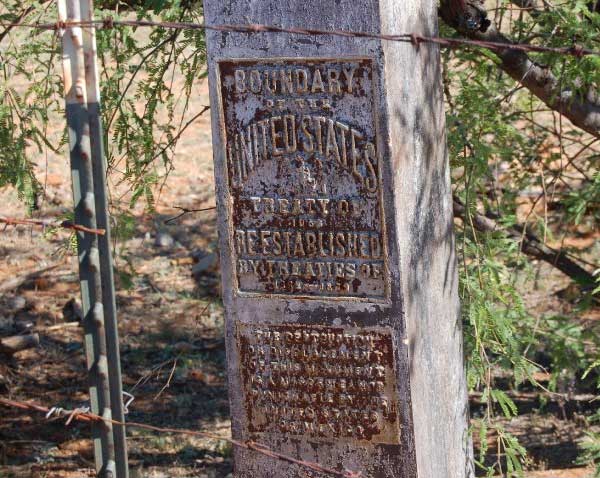
Arizona-Mexico Boundary Marker

